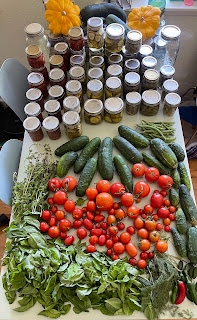Sourdough Starter
I've had limited success with sourdough in the past. Recently a colleague shared starter with me, and I've finally had some delightful baked goods!
I've tried to start my own sourdough, and if you can find someone who has some, I think it is easier to start from already active starter. Sourdough bread is also called friendship bread because the starter is shared among friends. I’ve seen free starter online on Facebook Marketplace, if you don’t know someone with starter.
You can tell if the sourdough starter is good by looking at the container and seeing if it bubbles. Good starter will be very bubbly and will raise about double what it started when you feed it. Your water needs to be at room temperature and filtered. Chlorine seems to have a negative effect on the starter.
Feeding the starter
To feed the sourdough you need to use equal parts of flour water and starter. A typical starter would use a half cup of flour, water, and starter. You can do larger quantities-I prefer a cup measure of all three.
Take the starter that you would normally discard and put it in a new jar and feed it. This is how you would go about sharing it with someone.
If you keep your sourdough starter in the refrigerator, it needs to be fed once a week. I pick a day I know I will be available and make that my sourdough starter day. If you leave it on the counter, it needs to be fed daily. The decision to keep it in the fridge or on the counter depends on how much sourdough baking you plan to do. If you’re baking with the sourdough starter in the refrigerator, you need to let it sit out overnight to warm up and be ready to go when you want to bake.
Because you discard starter that you don’t need when you are feeding it, you can use what you pour often in your baking. If you’re not baking, you can compost the sourdough starter. Rather than just throwing it in the trash or down the drain, this is a great use of your discards.
Sourdough at Altitude
High-altitude baking makes it a bit more challenging. Use a scale to measure the amount in grams so that it is exact. Different flours can have different weights, so using a scale makes it easier to compensate for that. I am less careful when I’m at sea level as the starter and breads are less sensitive. I generally measure without weighing and it seems to be fine.
I also have found that using Hungarian Flour for high-altitude baking makes a lot of difference in the success you will have when making sourdough breads and other sourdough recipes. Make certain that if you are using a scale to account for the weight of your container. I typically use an empty container and use the tare button on my scale to 0 to eliminate the weight of the container.
















